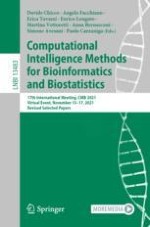2022 | Buch
Computational Intelligence Methods for Bioinformatics and Biostatistics
17th International Meeting, CIBB 2021, Virtual Event, November 15–17, 2021, Revised Selected Papers
herausgegeben von: Davide Chicco, Angelo Facchiano, Erica Tavazzi, Enrico Longato, Martina Vettoretti, Anna Bernasconi, Simone Avesani, Paolo Cazzaniga
Verlag: Springer International Publishing
Buchreihe : Lecture Notes in Computer Science
